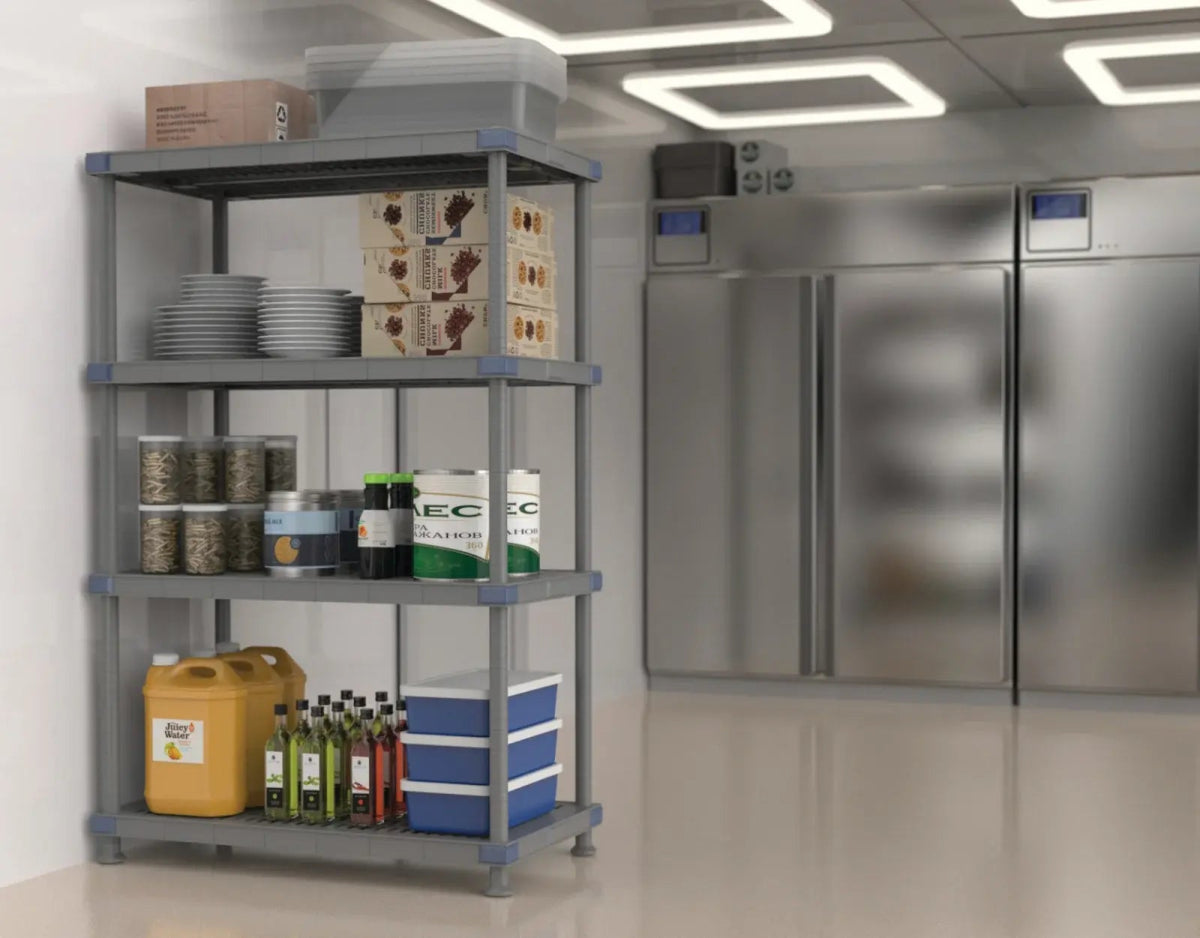I had a super interesting chat today with someone who’s seen it all in the commercial refrigeration world. This guy went from selling fridge units, to setting up coolers and freezers for big kitchens and event places, and now he's over in Hawaii working with a seafood distributor. We hit it off right away, especially when he got all excited about epoxy shelving. He couldn’t stop talking about how it fights off rust and corrosion, and that 15-year warranty really caught his eye. Then he threw out the term “chiller” – something totally new to me. That got me digging into what exactly these terms mean, leading me to lay out the differences between walk-in freezers, coolers, and chillers, based on our chat and a bit of my own research. And of course, since its us, we'll add in some details on the proper shelving and storage solutions for freezers, coolers and chillers alike.
The terms "walk-in freezer," "cooler," and "chiller" refer to types of refrigerated spaces used to store perishable goods at different temperature ranges, each serving distinct purposes across various industries like food service, pharmaceuticals, and more. Here's a detailed look at the differences:
Walk-in Freezer
- Temperature Range: Walk-in freezers are designed to keep temperatures much lower than coolers and chillers, typically below 0°F (-18°C) or even colder.
- Purpose: They are used to store food or other perishable items that need to be kept frozen for long periods to prevent spoilage and maintain quality.
- Construction: To maintain these low temperatures, walk-in freezers are equipped with thicker insulation and more powerful refrigeration systems compared to coolers and chillers.
Walk-in Cooler
- Temperature Range: Walk-in coolers are designed to maintain temperatures above freezing, usually between 35°F (1.7°C) and 40°F (4.4°C).
- Purpose: They are ideal for storing fresh produce, dairy products, and other perishables that require a cool environment but do not need to be frozen.
- Construction: While they also have insulation, the thickness and type might be less substantial than in freezers, as the required temperatures are not as low.
Chiller
- Temperature Range: Chillers can vary in the exact temperature range they maintain, but they are generally used to keep products cool, often between 32°F (0°C) and 50°F (10°C), depending on the specific application.
- Purpose: Chillers are used in both food storage and industrial applications (such as process cooling) to remove heat from a liquid via a vapor-compression or absorption refrigeration cycle.
- Types: There are different types of chillers, including air-cooled and water-cooled chillers, depending on their cooling mechanism and application.
Key Differences
- Application: Freezers are for long-term storage of frozen products, coolers for short-term storage of perishables at cool temperatures, and chillers often have broader applications, including non-food industrial uses.
- Temperature Control: Freezers operate at the lowest temperatures, coolers at medium-low temperatures to prevent freezing, and chillers can be adjusted for a range of cooling needs.
- Construction and Insulation: Freezers require the most robust construction and insulation, followed by coolers, with chillers' requirements depending on their specific use case.
Shelves & storage bins for walk-in freezers, coolers, and chillers
Shelves & storage bins for walk-in freezers, coolers, and chillers must be designed to withstand the environmental conditions of each unit, along with the specific requirements of the items being stored. Here are some of the key characteristics to consider for shelves and storage bins in these units:
Material Durability
- Corrosion Resistance: Materials that resist corrosion, such as stainless steel, aluminum, or heavy-duty, coated shelving, are essential, especially in the humid and cold environments of freezers and coolers.
- Strength: Shelving and bins must be capable of supporting the weight of the stored items without bending or breaking. This often means selecting heavy-duty materials and construction.
- Non-toxic: Materials should be non-toxic and safe for storing food and other sensitive items, ensuring they do not leach chemicals or odors into the stored goods.
Temperature Resistance
- Withstand Low Temperatures: Materials used in freezers, in particular, must be able to withstand very low temperatures without becoming brittle and cracking.
- Thermal Stability: Materials should have minimal expansion and contraction with temperature changes to maintain structural integrity over time.
Hygiene and Cleanliness
- Easy to Clean: Surfaces should be smooth and easy to clean, with minimal crevices where dirt and bacteria can accumulate. This is crucial for maintaining food safety standards.
- Moisture Resistance: Materials should resist moisture absorption to prevent mold, mildew, and bacteria growth, which is particularly important in cooler and freezer environments.
Ventilation
- Adequate Air Flow: Shelving design should allow for proper air circulation around stored items to maintain consistent temperatures and ensure efficient operation of the cooling unit. This can be achieved with wire shelving or shelves with perforations.
Modularity and Adjustability
- Adjustable Shelves: The ability to adjust shelf heights is important to accommodate different sizes of products and optimize space usage.
- Modular Design: Modular bins and shelves that can be easily reconfigured or expanded are beneficial for changing storage needs.
Safety
- Secure Mounting: Shelving units should be securely mounted and stable to prevent tipping or collapsing, which could damage stored goods or injure workers.
- Ergonomic Design: Consideration for ergonomics to ensure that shelves and bins are at safe and convenient heights for access, reducing the risk of strain or injury.
Specific Considerations
- Freezers: In freezers, the importance of temperature-resistant materials and strength is heightened due to the extreme temperatures.
- Coolers: In coolers, corrosion resistance and moisture resistance are particularly critical due to the cooler, humid environment.
- Chillers: For chillers used in industrial applications, the specific chemicals or products being cooled may require specialized materials that resist chemical degradation or contamination.

